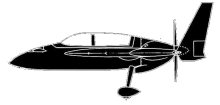
ASN Wikibase Occurrence # 35360
This information is added by users of ASN. Neither ASN nor the Flight Safety Foundation are responsible for the completeness or correctness of this information.
If you feel this information is incomplete or incorrect, you can submit corrected information.
| Date: | Thursday 17 December 1992 |
| Time: | 19:35 LT |
| Type: |  Rutan Long-EZ |
| Owner/operator: | Robert E. Anderson |
| Registration: | N777CJ |
| MSN: | 1114 |
| Total airframe hrs: | 588 hours |
| Engine model: | Lycoming O-235-L2C |
| Fatalities: | Fatalities: 1 / Occupants: 2 |
| Aircraft damage: | Destroyed |
| Category: | Accident |
| Location: | Tucson, AZ -
 United States of America United States of America
|
| Phase: | Manoeuvring (airshow, firefighting, ag.ops.) |
| Nature: | Private |
| Departure airport: | |
| (KRYN) | |
| Investigating agency: | NTSB |
| Confidence Rating: |
THE EXPERIMENTAL HOMEBUILT AIRCRAFT WAS BEING DEMONSTRATED BY THE PILOT TO A POTENTIAL BUYER, WHO WAS A PASSENGER IN THE REAR TANDEM SEAT. THE ENGINE DID NOT HAVE AN ELECTRIC STARTER INSTALLED ON THE ENGINE. ACCORDING TO THE PASSENGER, THE PILOT WAS DEMONSTRATING THE LOW SPEED HANDLING CHARACTERISTICS OF THE AIRCRAFT AT AN ALTITUDE HE ESTIMATED AT ABOUT 3,000 FEET AGL. THE PILOT BROUGHT THE THROTTLE TO IDLE, AND, AS THE AIRCRAFT SLOWED, THE ENGINE CEASED TO RUN AND THE PROPELLER STOPPED TURNING. THE PILOT WAS UNABLE TO AFFECT AN AIRSTART OF THE ENGINE AND THE AIRCRAFT COLLIDED WITH THE GROUND WHILE THE PILOT WAS ATTEMPTING A FORCED LANDING ON A ROAD. DETAILED EXAMINATION OF THE ENGINE REVEALED NO EVIDENCE OF A PREIMPACT MECHANICAL MALFUNCTION OR FAILURE. THE EMERGENCY PROCEDURES SECTION OF THE AIRCRAFT OWNERS MANUAL STATES THAT AN AIRSPEED OF 70 KNOTS OR MORE IS REQUIRED TO MAINTAIN ENGINE ROTATION AT IDLE. THE MANUAL FURTHER STATES THAT THE ENGINE STOPS TURNING, A DIVE SPEED OF 130 KNOTS OR MORE IS REQUIRED TO REGAIN ENGINE ROTATION WITH AN ALTITUDE LOSS OF GREATER THAN 2,000 FEET.
Probable Cause: THE PILOT'S FAILURE TO MAINTAIN AN AIRSPEED OR POWER SETTING SUFFICIENT TO MAINTAIN ENGINE ROTATION DURING THE LOW SPEED DEMONSTRATION. A FACTOR IN THE ACCIDENT WAS THE INSUFFICIENT ALTITUDE TO AFFECT AN ENGINE RESTART ONCE THE PROPELLER STOPPED TURNING.
Accident investigation:
 |
|
Sources:
NTSB LAX93LA069
Location
Revision history:
| Date/time | Contributor | Updates |
|---|---|---|
| 24-Oct-2008 10:30 | ASN archive | Added |
| 21-Dec-2016 19:22 | ASN Update Bot | Updated [Time, Damage, Category, Investigating agency] |
| 10-Apr-2024 16:17 | ASN Update Bot | Updated [Time, Operator, Other fatalities, Destination airport, Source, Narrative, Category, Accident report] |
Corrections or additions? ... Edit this accident description
The Aviation Safety Network is an exclusive service provided by:


 ©2024 Flight Safety Foundation
©2024 Flight Safety Foundation